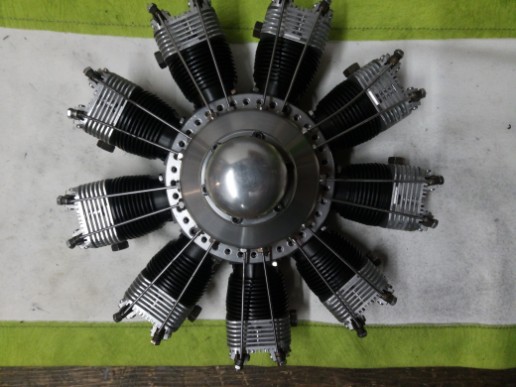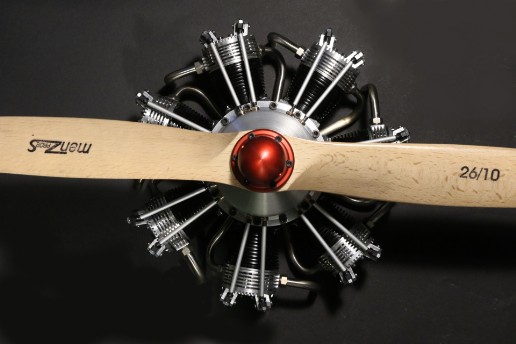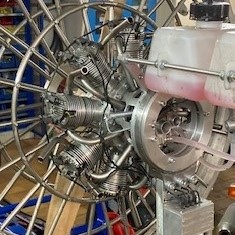Gallery > Galleries helicopters/engines
Gallery radial engines
Below are photos of radial engines that were created according to the CAD+Modelltechnik Jung construction plans.
Many thanks to all senders of the photos!
If you as a customer of "CAD+Modelltechnik Jung" would also like to present photos of your manufactured engines here, then simply send us an email to: cad-modelltechnik-jung@web.de

Attached are some photos of the 9-cylinder radial engine (150 cc displacement), built by Mr. Norman Grigat. The engine is still under construction and will soon be completed and then undergo its first test runs. Mr. Grigat designed the radial engine with a minor modification to the cylinder heads. These are square instead of round.

Here are some photos and a video of the first test run of the 7-cylinder radial engine (displacement 120 cc), made by Mr. Bruno Engert from Switzerland. The radial engine has been made with a few detailed changes and has also been equipped to run on petrol with a Walbro carburettor and ignition system.
Mr. Engert writes in conclusion: "Bruno Engert, a proud owner of an extraordinary engine 😉"
In addition to building the engine, Mr. Engert has published a few YouTube videos (6 videos will gradually be published):

Attached are some photos of the 9-cylinder radial engine (capacity 150 ccm), manufactured by Mr. Bernd Mudersbach. The radial engine is mounted on a kettcar for demonstration purposes. To make starting the engine easier, it is equipped with a glow regulator from Hölzl.
Mr. Mudersbach writes about this: "My nine-cylinder radial engine runs like clockwork and I'm thrilled. So that I don't run out of further work and I need a new project, please also send me the construction plan of the 60 ccm boxer engine."
So we will soon be able to present even more from Mr. Mudersbach... let's call that enthusiasm!
Currently some photos of the construction of Andreas Frey's 5-cylinder radial engine. The result is really impressive! We congratulate on the great achievement.
Mr. Frey writes: "All work on the engine was processed with a conventional turning and milling machine, without CNC technology. The committee parts were kept within limits. Whether the engine is running, it will become clear in the summer. I no longer fly and it would also be a shame if I landed roughly with this great engine. I am fascinated by the technology and therefore I build the engines so that they can be displayed on a nice surface at my home."
The video opposite, found on Youtube, of a 7-cylinder radial engine with 120 cc, built according to our construction plan and assembled on a test bench. Unfortunately we only know the nickname of the builder "Tankieuro".
Here are some photos of the 7-cylinder radial engine manufactured by apprentices from Haimer GmbH.
Training manager Ludwig Regau writes: "Some time ago, the trainees at Haimer built a 7-cylinder radial engine based on your drawings. We also built a functional sectional model for our exhibition display. The missing 4 cylinders will be added shortly expanded. "
At the moment the Haimer company is also producing another engine according to our construction plans, the 9-cylinder radial engine.
There is a training video on Youtube about the company Haimer, see on the left.
Here are some photos by Markus van Tankeren of the completed 7-cylinder radial engine.
Here are some photos of the 5-cylinder radial engine, made by Mr. Bücheler.
On the left is a video, found on Youtube, of a 6-cylinder compressed air radial engine, built according to our construction plan.
On the left are some photos of the 6-cylinder compressed air radial engine by Bruno Engert, from Switzerland. Really beautifully made and presented.
Here are some photos of the 9-cylinder radial engine, made by Phil Wilson from England. The engine has been built with absolute perfection that is second to none. All parts, even the gears, were made in-house. The cylinders and the propeller spinner were even anodized on our own.
The engine is now mounted on a "Pitts Python", a double-decker aircraft with a wingspan of 2 meters. So the model is more than well motorized. A 26x16 inch Menz propeller (corresponding to 66 cm in diameter) is mounted, which the motor rotates at 5,200 rpm.
Mr. Phil Wilson also has a very informative and interesting blog about building the engine. Here, many components of the engine are shown and described step by step during production. Some videos complete the perfect construction documentation. A video of the Pitts Python can also be seen. All you can say is power in abundance.
Mr. Phil Wilson also has a very informative and interesting blog about building the engine. Here, many components of the engine are shown and described step by step during production. Some videos complete the perfect construction documentation. A video of the Pitts Python can also be seen. All you can say is power in abundance.
On the left are some photos of Klaus Winter's 5-cylinder radial engine. The engine has been completed since May 2006. Mr. Winter writes "the engine is functional, but since I am not a gifted model pilot, it only serves as an exhibition object."
Here are some photos of Bernd Gross's 3-cylinder radial engine. The photos show the engine spread out in the exploded view and the partially assembled radial engine. All individual parts of the engine are neatly lined up for the photo shoot before the final assembly.
On the left are some photos of Bernhard Presthofer's 7-cylinder radial engine. The photos show the engine in different views. Here, too, one can only say: perfect !.
The 120 cc engine is still waiting for the right model. Mr. Presthofer writes that he had a lot of fun building the engine.
Enclosed some pictures sent by Frank Kopelke. Mr. Kopelke is a lecturer at "FundC Gülzow". Here our construction plans are used as templates for the CAD-CAM training. The course participants reproduce component by component in 3D CAD and use them to create the assemblies up to the complete engine. The photos show the 9-cylinder radial engine and the 6-cylinder V-engine. Both CAD models were created using the Inventor software.
Here are some photos of the 7-cylinder radial engine from Tristan Kast (Switzerland). The engine has a displacement of 120 cc and was built by its builder with great attention to detail. The engine has already passed its first test runs with flying colors.
In one of the photos you can see the engine from the back. You can see u. a. the suction pipes of the 7 cylinders with the centrally arranged carburettor, as well as the neatly laid cables for the glow plug heater. The open crankcase is also clearly visible. The 6 secondary connecting rods attack the main connecting rod. The main connecting rod in turn runs on the crankshaft journal with needle bearings.
The YouTube video opposite shows the radial engine during one of the first test runs.
A few weeks ago we received mail from Spain. It included some photos of the 3-cylinder radial engine and 5-cylinder radial engine shown below. Both engines were built by Mr. Pereiras from Santaigo de Compostella. Thank you so much!
A few weeks ago Frank Schreiner called us from Oestrich-Winkel and reported on the first test run of the 9-cylinder radial engine he had built according to our construction plans. Mr. Schreiner was more than enthusiastic about the running properties of the radial engine. I.e. the engine shows flawless running behavior when idling, throttle response and full load. The speed can be reduced even further by glowing the candles while idling. The engine can be started by hand in cold and warm conditions. Mr. Schreiner currently operates the engine with approximately 8% oil and approximately 5% nitromethane additive. Of course I couldn't miss visiting the carpenter on site and seeing the engine in action. This is where the video of the running engine was created.
In the future, the engine should be installed in a true-to-original double-decker or possibly even in a "Gee Bee". The only changes to the engine compared to the construction plan are a one-piece cam drum with an inserted internal gear made of brass. The advantage is that the internal gear is much cheaper to purchase as a purchased part. This change will soon be included in the construction plan. In addition, the intake and exhaust pipes were made of aluminum tubing. This is easier to bend with the relatively narrow radii. All parts of the engine were created using a "normal" turning or milling machine. CNC machines were not used. The only little help: the piston and piston rings were procured from "CAD+Modelltechnik Jung". The finished 9-cylinder radial engine is first assembled on a test bench for test purposes. The assembled propeller is a wooden propeller from Menz with the dimensions 26 x 14 inches (corresponds to 66 diameter x 36 cm pitch!).
The video opposite shows the 9-cylinder radial engine on one of the first test runs on the test bench.
Mr. Bösch sent us some pictures of the now completed 5-cylinder radial engine (August 2007). Mr. Bösch writes: "The first attempt at start was a success. The response at idle, partial and full load is impeccable. And the sound, brilliant! On the attached photos you can see the engine during the first test run. After about 3-4 We measured hours of running-in time using a dynamometer (linear slide + spring balance, see pictures) a thrust of approx. 9.5 to 10 kg. The propeller 24x12 inch proposed according to the construction manual was installed. "
Mr. Bösch is head of the mechanical workshop at the Physics Institute at the Albert-Ludwigs University in Freiburg.
Michael Grobe sent us the two views of the 9-cylinder radial engine he had made. This special highlight of our construction plans series, with a total cubic capacity of 150 cc, impresses with the finest optics and a sound that is in no way inferior to the original radial engines.
Mr. Grobe reports the following performance characteristics of the engine:
- speed: 1,400 - 5,400 rpm, with a 3W propeller 28 "x 12" (corresponds to a diameter of 71 cm, with a pitch of 30.5 cm!)
- thrust: approx. 15 kg
- fuel: methanol with 8% oil, without nitro (no idle gas annealing required)
After the successful test run of the engine, it should be installed in a Focke Wulf FW-190 with a wingspan of 2.60 m.
Andreas Ahrens-Sander sent us these three photos of the 7-cylinder radial engine he was building.
The engine should be ready by May 2006 and will then be installed in a double-decker "Sopwith Pup", M 1: 3.3 from the Toni Clark range.
Mr. Ahrens-Sander writes the following: "The model has a wingspan of 2,450 mm (both wings) and a length of 1,840 mm. The double-decker will probably weigh 15.5 kg. The radial engine fits well under the hood with 30 cm. The engine is supposed to drive a 30 x 6 inch propeller. I hope it will work. I have planned the first flight for late summer 2006. "
For the next year, Mr. Ahrens-Sander is preparing an even larger project: a 1: 2.5 scale model of the "SE 5 a" double-decker with a wingspan of 3.25 m. There the 8-cylinder V-engine with a cubic capacity of 132 ccm, which is also offered as a construction plan by "CAD + Modelltechnik Jung", will drive a 32x6 or 32x8 inch propeller.
The "SE 5 a" is a British fighter plane from 1916, which also had a V8 engine installed in the original.
Three of the 5-cylinder radial engines are currently being built at the IHK in Dillenburg. Manfred Lang sent us the two photos.
From the photo above you can see that a large part of the individual parts have already been completed.
All 15 pieces of pistons including rings and the 30 pieces of valves were provided by "CAD+Modelltechnik Jung".
In the photo below you can see the machining of a crankcase. According to Mr. All three engines are to be finished by the end of May 2005 and of course your baptism of fire will then pass on a test bench.
Michael Krüger has just sent us some pictures of the completed 9-cylinder radial engine (as of August 2007). For the first test run, the engine is mounted on a test stand (see picture above).
The picture below shows the complete crank and cam drum housing with the main connecting rod already installed and the 8 secondary connecting rods. The connecting rods, the engine mount and parts of the crankcase are cast from aluminum in a modification of the blueprint. The cam drum is also made in one piece, case hardened and with an eroded ring gear. Mr. Krüger writes: "All parts (except for the rolling bearings) are built on small" China machines "(converted to NC operation and with some improvements and adjustments ...) and an "old" (but no old iron!) Steinel SH4d milling machine. All heat treatment and casting work were carried out in the own workshop. Only the eroding was carried out in a friendly workshop. "
Hr. Krüger's expertise in the aluminum casting process of the above Share on. You can contact us via Mr. Krüger.
Also some photos of the previously completed 5-cylinder radial engine (displacement 82 cc) from our series of construction plans.
Evangelos Paschaloudis from Thessaloniki (Greece) sent us this picture of the 5-cylinder radial engine. Mr. Paschaloudis reported that the engine will later be mounted in a double-decker aircraft.
Josef Plöchinger also sent us a picture of the 5-cylinder radial engine he had built.
Kurt Seidl sent us the picture of the completed 5-cylinder radial engine. Many thanks!
Reprint only with the permission of the author. All statements without guarantee.
Note on all links on these pages:
With judgment of May 12th, 1998 - 312 O 85/98 - "Liability for links" the regional court Hamburg decided that the operator of a homepage has to take responsibility for the contents of the linked page. According to the court, this can only be prevented by expressly distancing yourself from this content.
We as CAD+Modelltechnik Jung expressly distance ourselves from all content on all linked sites and do not adopt their content as our own. This declaration applies to all available links on the pages of this web portal.